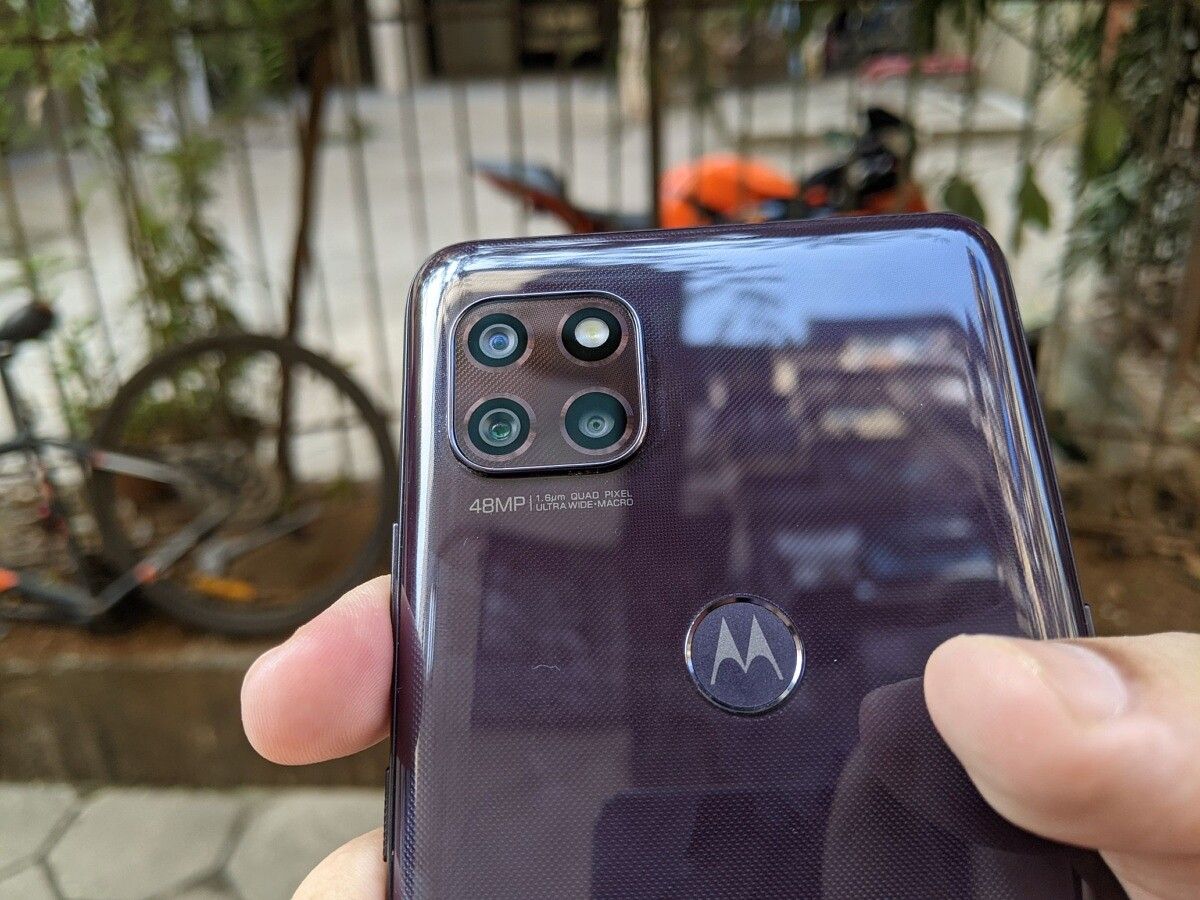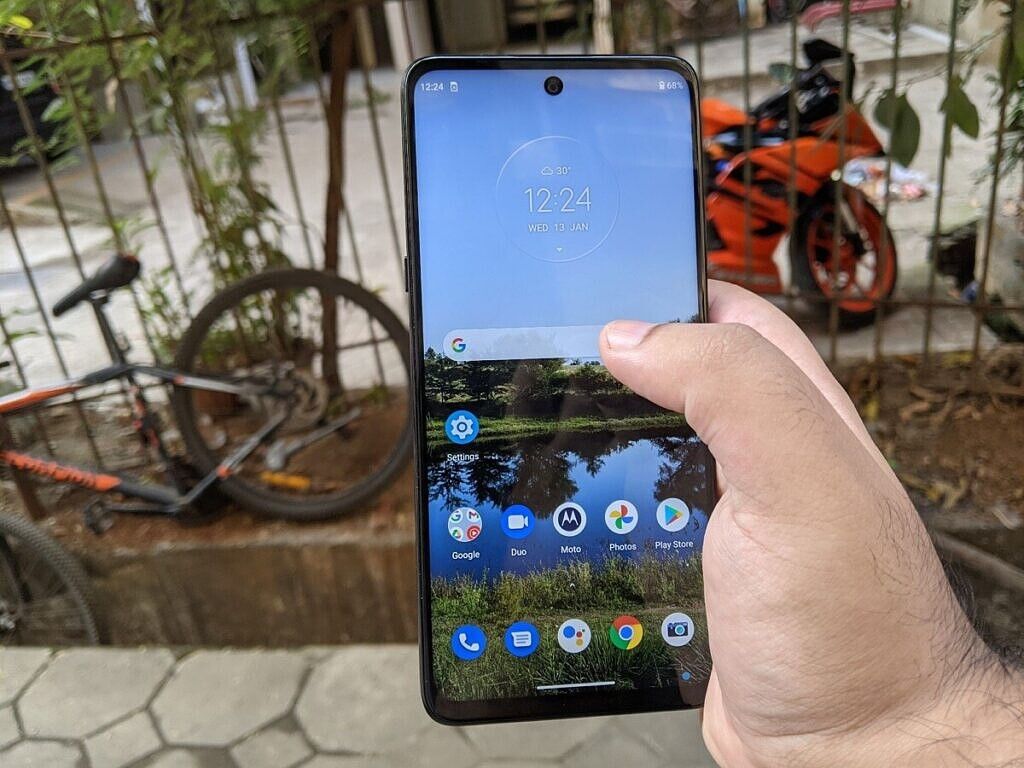For years, Motorola had fallen behind in the budget and mid-range segments of the smartphone market. The company’s smartphone releases didn’t compete well in terms of specifications and value-for-money against offerings from Xiaomi, Realme, and even Samsung. At one point, it seemed Motorola could not recover from its self-inflicted wounds, as the brand increasingly slid into irrelevance. Since the latter half of 2018, however, it has started a bit of a course correction, with phones such as the Motorola One Power, Motorola One Action, and especially the well-received Motorola One Fusion+ in mid-2020. The Moto G 5G, launched in December as the company’s first mid-range 5G phone, aims to carry on this momentum.
Apart from 5G support and the new Qualcomm Snapdragon 750G SoC, the Moto G 5G doesn’t have many distinguishing features. It doesn’t have an AMOLED display, nor does it have a high refresh rate display. The battery capacity is a hefty 5,000mAh, but even that doesn’t stand apart anymore when competitors now have 6,000mAh and even 7,000mAh batteries. The camera setup looks run-of-the-mill on paper as well. On the other hand, it can be thought of as a phone that goes back to the basics and tries to execute them well. From the beginning, it’s an open question whether the Moto G 5G can compete against phones such as the Xiaomi Mi 10i, POCO X3, Realme 7 Pro, Samsung Galaxy M51, and the OnePlus Nord. Let’s see how it does.
|
Specification |
Motorola Moto G 5G |
|---|---|
|
Build |
Plastic |
|
Dimensions & Weight |
|
|
Display |
6.7-inch Full HD+ hole-punch IPS LCD |
|
SoC |
Qualcomm Snapdragon 750G |
|
RAM & Storage |
6GB/128GB |
|
Battery & Charging |
|
|
Security |
Rear-mounted fingerprint sensor |
|
Rear Camera(s) |
|
|
Front Camera(s) |
16MP |
|
Port(s) |
|
|
Audio |
Downward firing mono speaker |
|
Connectivity |
Wi-Fi 802.11ac / Bluetooth 5.1 / NFC / A-GPS |
|
Software |
Android 10 |
About this review: Motorola India sent me the 6GB RAM + 128GB storage variant of the Moto G 5G. I used the phone for a month before returning the review unit. Motorola had no input on the content of this article.
Moto G 5G - Design
The Moto G 5G has a pretty standard design for a 2020 mid-range phone. You get a 6.7-inch display with a centered hole-punch front camera. There is a matte plastic frame. The back is made of a glossy plastic material and has an interesting textured rainbow effect underneath. The build quality won’t win any awards as there is no metal and glass construction to be seen here, but that’s not necessarily a bad thing at this price point.
The thickness and weight figures are acceptable as well at 9.9mm and 212 grams respectively. The Samsung Galaxy M51 manages to fit in a larger 7,000mAh battery in a thinner footprint while maintaining the same weight, though, which is a bit of a minus for the Moto G 5G.
In terms of ergonomics and in-hand feel, the Moto G 5G holds itself up admirably. The matte finish of the plastic frame helps for grip, and the curved back with slightly rounded sides is beneficial for ergonomics. The power and volume buttons are placed on the right side, while a Google Assistant button is placed on the left side. It’s all unremarkable, but not in a bad way.
The top-left side of the back contains the square camera enclosure with symmetrical placement of the 48MP + 8MP + 2MP sensors along with the LED flash. Thankfully, the camera bump is minor thanks to the thickness of the frame, which is good to see. Motorola has opted to stick with a rear-mounted physical capacitive fingerprint sensor, instead of integrating it with the power button. It works very well, as expected.
The color options of the phone are simple: Black and Silver. The phone does have an understated charm in the black color, as it doesn’t stand out at all due to the fact that in terms of color, it’s a monolith.
The Moto G 5G has IP52 water and dust resistance. There’s a dedicated microSD card as well.
Overall, the Moto G 5G’s design is unexciting but still acceptable for a phone in the mid-range segment. You can find phones with better looking gradient finishes, more premium material construction, and phones with water resistance. Even the Motorola One Fusion+ had a more attractive design. The Moto G 5G skips out on all three, but for most buyers in this price range, these factors probably won’t matter much.
Moto G 5G - Display
The Moto G 5G’s display is unexciting, just like its design. It has a 6.7-inch LTPS IPS LCD with HDR10 support. The HDR10 support is nice to see, but it’s becoming prevalent in this price segment, so the phone doesn’t bring anything new in this respect. The lack of either one of the two major headlining display characteristics is found on the Moto G 5G, as its display is not AMOLED unlike the Galaxy M51 and the Realme 7 Pro, and it doesn’t have a high refresh rate unlike the Xiaomi Mi 10i, POCO X3, and others. So it’s 0/2, which reflects poorly on Motorola especially at this price point.
The lack of a high refresh rate display is probably the biggest downer with this phone. The lack of AMOLED means contrast levels are just OK, while there is brightness and contrast degradation across viewing angle changes. On the other hand, the display does perform well when weighed on the scale of other factors such as resolution, brightness (although it doesn't have high brightness mode), minimal color shifting across viewing angles, and great color accuracy in the Natural color mode.
Sadly, these plus points of the display help, but don’t eliminate, the want for a high refresh rate (at least 90Hz) display, which is increasingly starting to become a requirement in new phone launches.
Moto G 5G - Performance
The Moto G 5G is powered by Qualcomm’s new Snapdragon 750G SoC. It has two newer ARM Cortex-A77 big cores that pair the six ARM Cortex-A55 little cores, an upgrade over the Snapdragon 730G and the Snapdragon 765G, which both have Cortex-A76 big cores. In terms of the GPU, you get an Adreno 619. Qualcomm’s GPU nomenclature means this is faster than the Adreno 618 of the Snapdragon 730G and the Adreno 619L of the Snapdragon 690, but it will fall short of the Adreno 620 in the Snapdragon 765G, not to mention flagship GPUs such as the Adreno 630 and above, found in the Snapdragon 800 series.
|
Benchmarks |
Moto G 5G |
|---|---|
|
Geekbench 5 Single Core |
659 |
|
Geekbench 5 Multi-Core |
1980 |
|
GFXBench Car Chase Offscreen OpenGL ES 3.1 |
19fps |
|
GFXBench Manhattan Offscreen |
45 fps |
|
3DMark Sling Shot Extreme - Vulkan |
2608 |
|
AndroBench sequential read and write speeds |
919.27 MB/S Sequential Read; 473.85 MB/S Sequential Write |
|
AndroBench random read and write speeds |
Random Read: 174.59 MB/s, 44695.18 IOPS (4KB); Random Write: 153.55 MB/s, 39310.37 IOPS (4KB) |
In terms of CPU performance, the Moto G 5G performs better than Snapdragon 730G as well as Snapdragon 765G devices, especially in single-threaded performance thanks to the 20% improvement in IPC that the Cortex-A77 brings over the Cortex-A76.
The GPU performance, on the other hand, is par for the course, but it’s not particularly impressive given Qualcomm’s reluctance to power its mid-range SoCs with more powerful GPUs. A POCO F1 from 2018 will have better GPU performance than the Moto G 5G, for example, and they were both launched at the same price. So at least in GPU performance, the market has yet to move forward.
The storage performance figures were a lot better. The phone has UFS 2.1 storage and was able to post some surprisingly high numbers, which means storage speed won’t be a bottleneck for system performance.
The real-world performance of the Moto G 5G is good. It doesn’t have a high refresh rate display, which means it won’t feel as fast and smooth as some competitors, despite having more performance to spare. The system UI was mostly free from perceptible frame drops. The RAM management was pretty good as well, and so were thermals, as they never became a cause for concern. In terms of unlocking speed, the Moto G 5G is one of the top performers as it doesn’t have to deal with a wonky implementation of an optical under-display fingerprint sensor.
Overall, the Moto G 5G’s performance is good for the price point. It excels in some aspects and underwhelms in others.
Moto G 5G - Camera
The Moto G 5G has a 48MP primary camera with the Samsung ISOCELL GM1 sensor. Ultra-wide photography duties are handled by an 8MP camera, while the tertiary camera is one of those filler 2MP macro cameras that don’t prove their worth on the specifications list. The phone can record 4K video at 30fps.
The specifications of all three cameras are not on par with expectations. The 48MP ISOCELL GM1 is a two-year-old sensor, and Motorola should have used the newer 64MP ISOCELL GW1 or the Sony IMX686. The macro camera should not have made its way into this phone. The number of cameras does not directly correspond to the image quality.
Here are some quick observations about the camera app and the image quality of the cameras:
- The camera app is fast to open and switches between modes quickly. Its design is different from conventional camera apps, but it works well.
- The 48MP primary camera takes average 12MP pixel binned photos. There is no option to take full-resolution photos, but that doesn’t matter in the end. Photos have adequate amounts of detail, but the exposure and dynamic range are notable issues as most photos are too underexposed. On the other hand, the noise reduction isn’t too aggressive, so fine detail retention is better than I expected.
- The 8MP ultra-wide-angle has a wide field-of-view, but its resulting photos have poor detail retention, as expected. It’s acceptable for the price point, though.
- Indoor photos have adequate detail but are severely affected by a low amount of contrast, underexposure, and poor color accuracy. The noise reduction is too strong here.
- Outdoor low-light photos are also underexposed, which means they don’t capture as much light as expected. However, detail levels are acceptable and luminance noise levels are low.
- The night vision mode is a big disappointment as it simply brightens up the photos while destroying all the detail. The oil painting effect here is strongly prevalent, to the point where it ruins image quality. This mode, therefore, should be avoided and used only as a last resort. Other competitors do much better here, even those that are cheaper than the Moto G 5G.
- There’s no 4K at 60fps video recording option, but the phone does have a 1080p at 60fps video recording option, albeit without EIS. 4K at 30fps and 1080p at 30fps videos have enabled EIS and have good image quality. The stabilization is also free from major issues.
- Overall, the Moto G 5G’s camera can be summed up in one word: disappointing. It does have a few strengths such as good detail levels in outdoor photos, but Motorola needs to seriously improve its image processing in indoor and outdoor low lighting environments. The night mode should be fundamentally overhauled as right now it’s effectively useless.
Moto G 5G - Battery Life and Charging
The Moto G 5G is powered by a 5,000mAh battery. The battery life is probably the strongest part of this phone. Thanks to the power-efficient 8nm Snapdragon 750G SoC, the lack of a high refresh rate display, and Motorola’s software optimizations, the Moto G 5G has excellent battery life.
In fact, the Moto G 5G's battery life is only slightly less than that of the Galaxy M51, which has a substantially larger 7,000mAh battery. I was able to get as much as 11.5 hours of screen-on time with two days of unplugged time. This is effectively twice the battery life of the OnePlus 8 Pro, for example. The Galaxy M51 was able to give as much as 13-15 hours of screen-on time, so it’s better but not so much better as the numbers would have you believe.
There is no wireless charging on the Moto G 5G, as expected. The 20W fast wired charging is slower than competitors such as Samsung’s 25W USB Type-C PD 3.0 charging as well as Realme’s 65W DaRT charging. At least Motorola bundles a charger in the box, though.
Overall, the Moto G 5G’s battery life is excellent, though it falls short of the Galaxy M51 and will also probably fall short of the POCO X3. The Mi 10i should have similar battery life, as its SoC + battery capacity combo is the same.
Odds and Ends
- I have not mentioned 5G support in this review so far. That’s because India doesn’t have any live 5G networks yet. The Moto G 5G’s 5G support is more for future-proofing. It supports the 3.5GHz 5G band, which is the one that will most likely be used by Indian 5G networks.
- The speaker quality of the Moto G 5G is par for the course. It’s neither outstanding nor poor.
- The vibration motor of the Moto G 5G is significantly better than that of the Galaxy M51, but it still won’t compare to vibration motors found in flagship phones, as expected.
Conclusion
On the one hand, the Moto G 5G attempts to go back to the basics. To a certain extent, it succeeds. The design and build quality are acceptable. The display performs well on the basis of traditional parameters such as brightness, viewing angles, and color accuracy. The CPU and system performance are good. The battery life is excellent. The presence of stock Android 10 with no added bloatware and no ads is a relief after seeing the bloatware infestation of custom user interfaces such as MIUI and One UI. The phone should receive an Android 11 update as well, but that will also probably be its last update. The camera takes relatively good photos in daylight.
However, the phone does have quite a few weaknesses as well. The lack of a glass back and gradient color options will disappoint those interested in flashy smartphone design. The lack of AMOLED is a turn-off for many users. The lack of a high refresh rate display is even more troubling as even cheaper phones now feature the technology. The GPU performance won’t compete with even 2018 smartphone flagships. The image quality of the camera indoors is poor, and the Night Vision mode requires a complete overhaul as it destroys detail. The battery life is excellent, but it’s not a USP in this price segment as phones like the POCO X3, Xiaomi Mi 10i, and the Samsung Galaxy M51 have equally good or even better battery life. Finally, Motorola’s software update record is worse than Samsung and Xiaomi. You can expect the Android 11 update to arrive at an uncertain time in the future, and nothing beyond that.
The phone’s list of competitors includes the Xiaomi Mi 10i, POCO X3, Realme 7 Pro, Samsung Galaxy M51, OnePlus Nord, Realme X3, and others. The Mi 10i is probably the closest competitor and comparing its specifications side-by-side, it does seem as if it is the better phone. It’s expected to have better camera performance as well, thanks to a 108MP primary camera and Xiaomi’s better night mode.
The Moto G 5G was launched for ₹20,999 in India. At that price, the phone offers a good value proposition, but others are clearly better in certain respects. The Galaxy M51 has a better display, the Mi 10i probably has a better camera, and the OnePlus Nord has more feature-rich software. The Moto G 5G, however, has its own strengths, and it is the right choice for the subset of users interested in a mid-range 5G phone without the bloatware of custom user interfaces.
The Moto G 5G is available in the U.S. as well under the Motorola One G 5G Ace moniker. It's a lot more expensive in that market, though, coming in at $399.99, which still makes it one of the most affordable 5G phones in the U.S.
Motorola Moto G 5G

- Flipkart
- View at Flipkart



